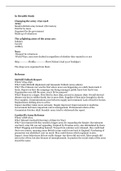In Breadth Study
Changing the army 1790-1918
Army
Modern British army formed 17th Century
Paid for by taxes
Organised by the government
Made up of volunteers
The 3 fighting arms of the army are:
Infantry
Cavalry
Artillery
Navy
-Manned by volunteers
-World Wars, men were drafted in regardless of whether they wanted to or not
Ship-----------Flotilla------------Fleet (Nelson’s had 33 at Trafalgar)
The ships were organised into fleets
Reforms
McNeill Tulloch Report
When? 1855-1856
Who? John McNeill (diplomat) and Alexander Tulloch (army admin)
Why? The Crimean war was the first where news was happening on a daily basis made it
home. Report on how the campaign was being managed, public knew how bad it was.
Organisation was still the same, was it fit for purpose?
What? Report in 2 stages. First filed in June 1855, second in January 1856. Overall showed
disease was key in soldier death, due to poor diets. Supplies of lime juice brought in slowly.
Poor supplies. Communications poor between supply and command. Lack of food for horses.
Replacement clothing slow to arrive.
Impact-Ancillary taken more seriously. Supply improved. Improvements to medicine.
Government had more important role in management. Professional reform of the
Commistrat October 1858. Scandal- army tried to whitewash the report.
Cardwell’s Army Reforms
When? 1868-1874
Who? Edward Cardwell (Secretary of State for War)
Why? Government felt they needed a bigger army for expanding the Empire. Recruitment
was hard, army life was not appealing. Inspired by Prussian army, also intimidated by them.
What? Flogging and branding banned. Troops from colonies were released- they could lead
their own armies, meaning many British troops could come back to England. Purchasing of
promotion was abolished- now on merit. Men could choose which regiment to join.
Impact- Army behaviours did not really change- top-down did not work. More people did
join in the 1870s, but also because of unemployment. In practise the social strata of the army
stayed the same.





